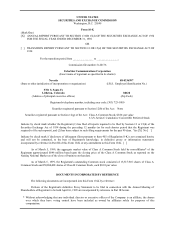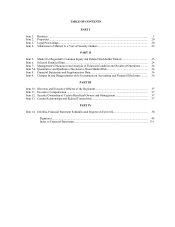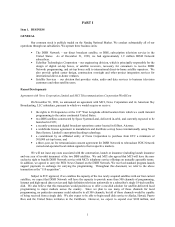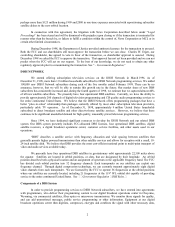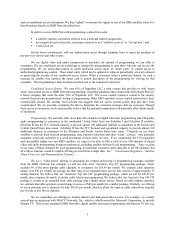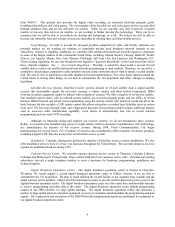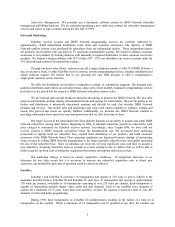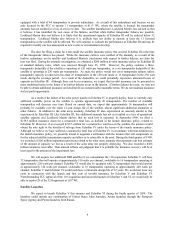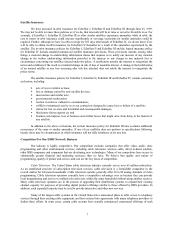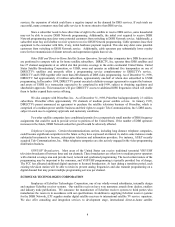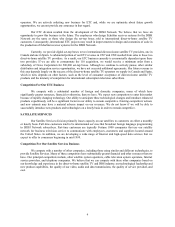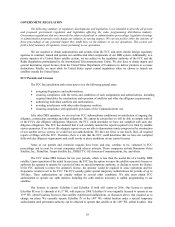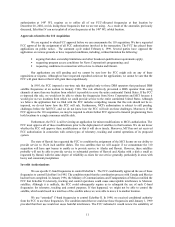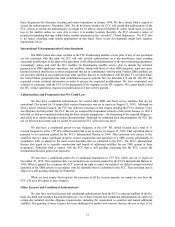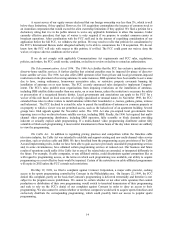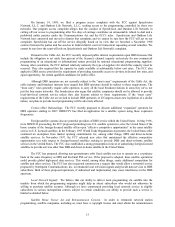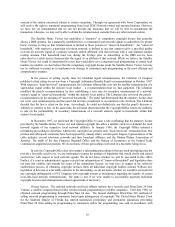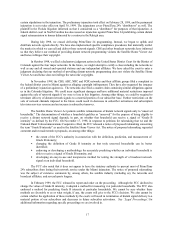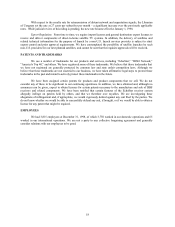Dish Network 1998 Annual Report Download - page 10
Download and view the complete annual report
Please find page 10 of the 1998 Dish Network annual report below. You can navigate through the pages in the report by either clicking on the pages listed below, or by using the keyword search tool below to find specific information within the annual report.8
services, the expansion of which could have a negative impact on the demand for DBS services. If such trials are
successful, many consumers may find cable service to be more attractive than DBS service.
Since a subscriber needs to have direct line of sight to the satellite to receive DBS service, some households
may not be able to receive DISH Network programming. Additionally, the initial cost required to receive DISH
Network programming may deter some potential customers from switching to DISH Network service. Additionally, a
subscriber must buy an EchoStar receiver system to receive DISH Network programming. Cable operators lease their
equipment to the consumer with little, if any, initial hardware payment required. This also may deter some potential
customers from switching to DISH Network service. Additionally, cable operators pay substantially lower royalty
rates for the retransmission of distant network and superstation signals than we do.
Other DBS and Direct-to-Home Satellite System Operators. Several other companies have DBS licenses and
are positioned to compete with us for home satellite subscribers. DIRECTV, Inc. operates three DBS satellites and
has 27 channel assignments at an orbital slot that provides coverage to the entire continental United States. United
States Satellite Broadcasting Corporation, or USSB, owns and operates an additional five transponders on one of
DIRECTV’s satellites and presently offers a programming service complementary to DIRECTV’s service.
DIRECTV and USSB together offer more than 200 channels of DBS video programming. As of December 31, 1998,
DIRECTV had approximately 4.5 million subscribers, approximately one-half of whom also subscribed to USSB
programming. In December 1998, DIRECTV’s parent executed a definitive merger agreement to acquire the business
and assets of USSB in a transaction expected to be completed in mid-1999, subject to obtaining regulatory and
shareholder approvals. This transaction will give DIRECTV access to additional DBS frequencies which will enable
them to further expand their service offering.
We also compete with PrimeStar, Inc. As of December 31, 1998, PrimeStar had approximately 2.3 million
subscribers. PrimeStar offers approximately 150 channels of medium power satellite service. In January 1999,
DIRECTV’s parent announced an agreement to purchase the satellite television business of PrimeStar, which is
comprised of a medium power satellite business and their rights to acquire Tele-Communications, Inc.’s DBS assets,
subject in each case to regulatory approvals and customary conditions.
Two other satellite companies have conditional permits for a comparatively small number of DBS frequency
assignments that could be used to provide service to portions of the United States. If the number of DBS operators
increases in the future, DISH Network subscriber growth could be adversely affected.
Telephone Companies. Certain telecommunications carriers, including long distance telephone companies,
could become significant competitors in the future as they have expressed an interest in, and in some instances made
substantial investments to become, subscription television and information providers. For instance, AT&T recently
acquired Tele-Communications, Inc. Other telephone companies are also actively engaged in the video programming
distribution business.
VHF/UHF Broadcasters. Most areas of the United States can receive traditional terrestrial VHF/UHF
television broadcasts of between three and ten channels. These broadcasters are often low to medium power operators
with a limited coverage area and provide local, network and syndicated programming. The local content nature of the
programming may be important to the consumer, and VHF/UHF programming is typically provided free of charge.
The FCC has allocated additional digital spectrum to licensed broadcasters. At least during a transition period, each
existing television station will be able to retain its present analog frequencies and also transmit programming on a
digital channel that may permit multiple programming services per channel.
ECHOSTAR TECHNOLOGIES CORPORATION
Employees of EchoStar Technologies Corporation, one of our wholly-owned subsidiaries, internally design
and engineer EchoStar receiver systems. Our satellite receivers have won numerous awards from dealers, retailers
and industry trade publications. We outsource the manufacture of EchoStar receiver systems to third parties who
manufacture the receivers in accordance with our specifications. In addition to supplying EchoStar receiver systems
for the DISH Network, ETC supplies similar digital satellite receivers to international satellite TV service operators.
We also offer consulting and integration services to development stage, international direct-to-home satellite

